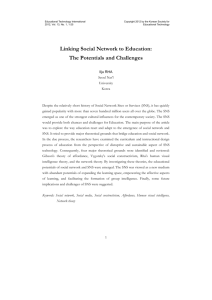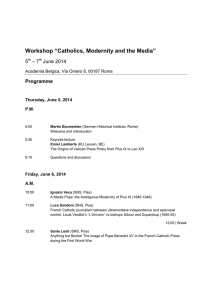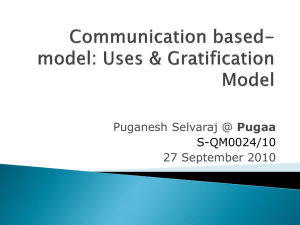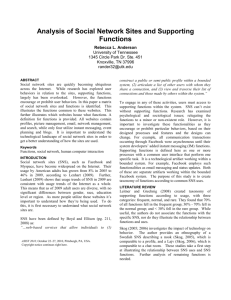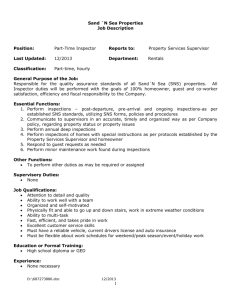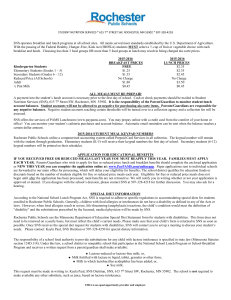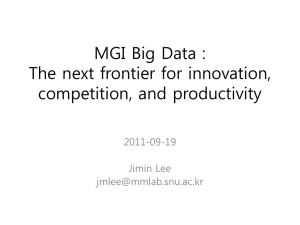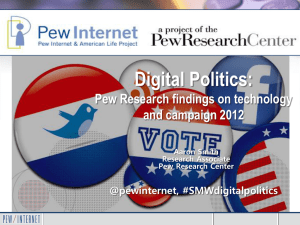Look at me! - Digital Culture & Education
advertisement
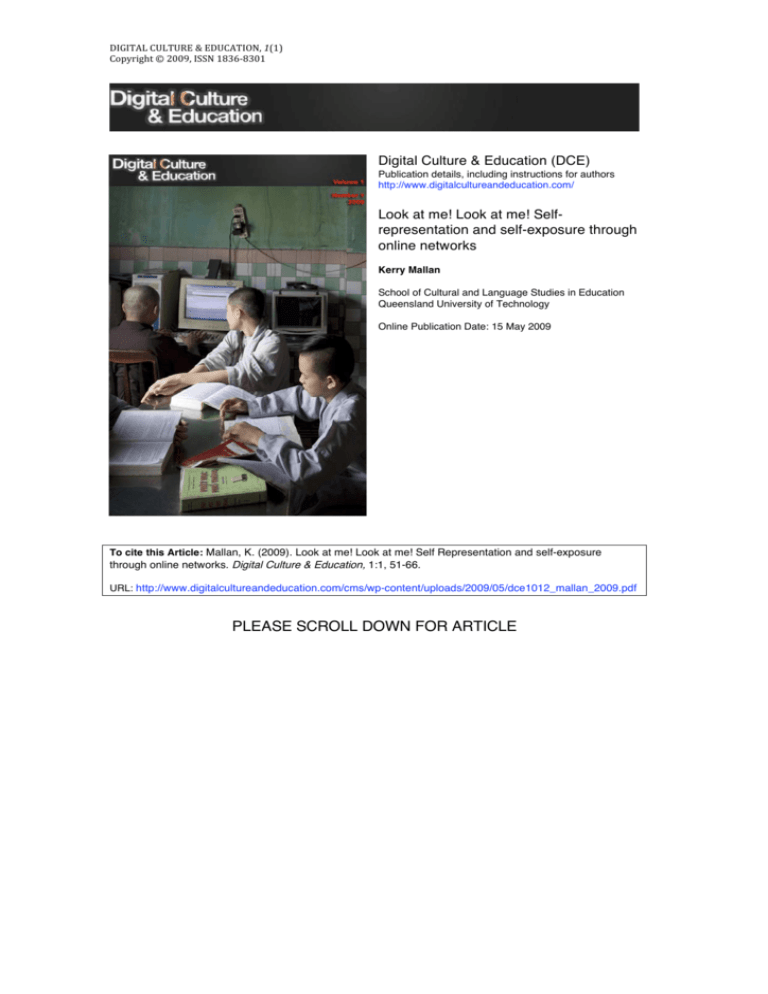
#" !" Digital Culture & Education (DCE) Publication details, including instructions for authors http://www.digitalcultureandeducation.com/ Look at me! Look at me! Selfrepresentation and self-exposure through online networks Kerry Mallan School of Cultural and Language Studies in Education Queensland University of Technology Online Publication Date: 15 May 2009 To cite this Article: Mallan, K. (2009). Look at me! Look at me! Self Representation and self-exposure through online networks. Digital Culture & Education, 1:1, 51-66. URL: http://www.digitalcultureandeducation.com/cms/wp-content/uploads/2009/05/dce1012_mallan_2009.pdf PLEASE SCROLL DOWN FOR ARTICLE Look at me! Look at me! Self-representation and self-exposure through online networks Kerry Mallan School of Cultural and Language Studies in Education Queensland University of Technology Abstract With the ever more user-friendly Web, the opportunities to use available channels of online communication complicate ways in which individuals oscillate between exhibition and inhibition, self-exposure and self-preservation, authenticity and deception. This paper draws on empirical research with high school students to examine the ways in which youth represent themselves and interact with friends and others in online networks such as MySpace. The conceptual framework for the discussion draws on the politics of visibility and notions of spatiality. These twin factors have consequences for new modes of technologically-mediated modes of representation with respect to community, friends, communication, and recognition. They also are helpful for considering what self-exposure means in terms of trust, risk, and privacy. The paper argues that there is no escaping the fact that online networks and other related activities hold both promise and peril. However, in constructing new social practices that traverse public and private spaces, technology itself is a key player in shaping how a community contributes to an individual’s identity formation and social activities. Keywords Youth identity, social networking sites, social relations, risk, visibility, spatiality, MySpace Introduction In the popular imagination, young people’s involvement in social networking sites (SNS) such as MySpace, Facebook, Bebo, and Friendster has come to be inextricably connected to an emotional state of threat, vulnerability, or loss. This perception is reinforced by media reports of sexual harassment, dangers of drugs and alcohol, terrorism, online predators, school yard bullying, disease, and so forth. The result is that many adults may come to see young people as being at risk, reduced to ‘one who can be hurt’. Anxieties about young people’s participation with SNS and other online platforms often centre on the unknown capacity that new technologies have to create change or to disrupt. However, this fear of the unknown consequences of technological impact on our lives can be traced back through the history of capitalist development. As Bukatman notes, ‘much of the upheaval surrounding accelerated technological development is not unique to the Information Age: contemporary culture overlaps and restates many of the fears that inhered during the Machine and Nuclear Ages’ (1993, p. 4). However, what is often attributed to being a fear of technology per se is more correctly a fear or anxiety associated with new technological modes of being in the world. It is the convergence between technology and the human subject that gives rise to the conflicting peril and pleasure concerns that encircle young people’s participation in online communities. When young people construct profiles on MySpace or participate in blogs or play videogames, they actively construct shifting subject positions 51 to interface with the global reach of a distributed network. These subject positions are not just ontological states, but inevitably entail a politics of visibility, both at the personal level and at the level of technological infrastructure. It is this ‘visibility’ which gives rise to epithets of narcissism and susceptibility attributed to the ‘Look-at-me generation’ (Orlet, 2007). However, more optimistic reports arising from research in the field of digital cultures present the other side of the panics debate, highlighting the many advantages and opportunities of SNS and other online activities for communicating and coordinating social relations, creating an outlet for self-expression, developing new textual forms and social practices that blur public and private, and for accessing computer-supported community networks (Thomas, 2004; Jenkins, 2006; boyd, 2007; Livingstone, 2009). Rather than become swept up in a discourse of panic about the evils of online participation, it is perhaps more productive to gain understanding of why SNS are so popular and how young people manage the risks as well as the pleasures that these online communities afford. This article takes as its focus how young people manage their identities and social relations via the mediating tools of SNS. By drawing on empirical research undertaken with groups of high school students reporting on their participation in MySpace, I argue that issues of self-representation and self-exposure are more complicated than the popular rhetoric of threat, vulnerability and loss might suggest. Rather than be cast as vulnerable and solipsistic, the young people in the study demonstrated that their social networking is part of an evolving pattern of interspatial, intersubjective social practices. They also expressed a sophisticated awareness of risk factors. My discussion highlights how young people’s engagement with online communication and SNS oscillates between opposing states of exhibition and inhibition, self-exposure and self-preservation, authenticity and deception. From the outset, I want to emphasis that the research reported in this article relates to a sample of high school students and is not intended to be inclusive of all young people. Nevertheless, the students’ comments about their participation in SNS provide indicators of how issues of self-representation and self-exposure are being understood and managed by young people growing up in a networked society. The conceptual framework for my discussion considers how technology is mediating identities and social relations, enabling new modes of representation with respect to community, friends, communication, and recognition. These new technologically mediated representations are also helpful for considering what self-exposure means in terms of trust, risk, and privacy. Technologically mediated identities and social relations Conventional understandings of human identity, representation, and social relations are being revised in the light of technological mediation (Yaszek, 2002; Livingstone, 2009). By considering technological mediation as a productive rather than a disabling experience, Yaszek, Livingstone, and others (Alexander 2008; Sunstein 2006; boyd & Ellison 2007) have explored how a range of relationships to ourselves and with others offers positive and enabling outcomes. The idea that identity work occurs in a social context – in the interactions of the self with others – is not new (see for example, Cerulo, 1997; Valentine & Holloway, 2002). However, SNS provide new spaces and ways for virtual identities to be constructed, visually presented, and narrated. For boyd (2007), the act of creating and maintaining profiles on SNS serves as ‘an initiation rite’ into these spaces for young people, becoming an important part of contemporary youth culture. Albrechtslund (2008) makes a similar point by suggesting that participating in social networking is ‘about the act of sharing yourself – or your constructed identity – 52 with others’. This notion of ‘sharing yourself’ is one that concerns those who are wary of young people’s participation in SNS as it would seem to expose the individual to potential risks. However, ‘sharing’ is central to the services and tools that new and emerging technologies offer. The opportunities to replicate, simulate, and re-present are not only endemic to new technologies’ tools and their take up in SNS, but are also part of users’ expectations. Web 2.0, with its heterogenous and accessible platforms and services, is very much a part of a new generation of culture industries that enable new forms of identity work and social relations to be undertaken. Web-based services such as blogs, SNS, podcasting, and photo-sharing, have greatly increased connectivity by providing users with the tools and spaces to connect ‘based on their interests and personality’ (Alexander, 2008, p.151). These services have also enabled information to be produced and shared in what is described as a ‘democratic’ environment (Leuf & Cunningham, 2001, cited in Sunstein 2006, p. 149), whereby any user should be able to contribute information, edit existing contributions, comment on entries and discuss related matters. Given the democratic philosophy behind these services, it would seem that users have agency in that they can actively contribute to knowledge creation and distribution. However, agency for some might easily turn into others being denied agency. This double-edged situation emerges from human relationships and is not necessarily specific to SNS. However, the distributed network facility of SNS has the capacity to impact negatively on the individual in situations where abuse or breaches of privacy has occurred. As Livingstone (2009, p. 407) notes from her study, young people need to negotiate between the positive and negative aspects of online networking: Selves are constituted through interaction with others and, for today’s teenagers, self-actualization increasingly includes a careful negotiation between the opportunities (for identity, intimacy, sociability) and risks (regarding privacy, misunderstanding, abuse) afforded by internet-mediated communication. However, interactions with others may be compromised when the ‘identity’ of an individual contributor may be false, disguised or unknown. The result is that the technology mediates identity and enables a subject to eschew authenticity, if so desired. Authenticity and validation are significant issues that emerge in research that looks at self-presentation, image management, and social relations (boyd and Ellison, 2007). While the purpose of SNS has always been one of social connectivity, another serves as a means for identity validation. As boyd and Ellison note, SNS ‘serve as important identity signals that help people navigate the networked social world, in that an extended network may serve to validate identity information presented in profiles’ (2007, p. 219). In terms of new technologies’ ability to transform experience through various strategies of re-presentation and simulation, self-representation, SNS such as MySpace also enable users to ‘fake’ identity (boyd cited in boyd & Ellison 2007, p. 216) by renegotiating ‘authentic’ re-presentations of the self. In one sense, this creative textual production of the self subverts the validation process argued by boyd and Ellison. However, the counterpoint is that the narratives of identity and agency that have traditionally been available to young people are being complemented by new possibilities that are the direct outcome of their participation in the larger, technologically mediated world. Another side to the issue of authenticity of identity concerns how others perceive and make judgements about a person through the sharing of online information. 53 Walther and colleagues (2008) investigated how college students tended to make judgements about a Facebook profile based on information that ‘friends’ posted on their sites about that person. What this study found was: (i) (ii) (iii) It is good to have good looking friends in Facebook as you gain no advantage from looking better than your friends; Complimentary or prosocial statements by friends about profile owners improved the profile owner’s social attractiveness and credibility; Facebook has the potential to reinforce stereotypes and behaviours that could be harmful to young people (for example, if a target person is female and pictures of her drunk are posted on other people’s facebooks then she was denigrated whereas an attractive male in similar shots received admiration and respect). While Walther et al’s study confirms the double standards that persist in society, an outcome of their research that is interesting in terms of self-representation and selfexposure is that ‘friends’ statements significantly altered perceptions of profile owners’ (p. 44). One can alter his/her own details on their own profile or delete unwanted photographs; however, it is difficult to modify or manipulate statements made by others (for example, their pictures and wall postings). Walther’s research raises a significant question that warrants further research into textual authority of social networks, particularly, they ask: ‘Are we known by the company we keep?’ (p. 29). A concomitant feature of Web 2.0’s ability for connectivity is its enabling approach to identity construction that extends poststructuralist notions of how identity is constructed within language and discourse. The collaborative approach to identity construction undertaken in SNS or other Web 2.0 enabled spaces is similar to the creative process of the bricologe, as it draws on a diverse set of materials and tools. When an individual or a group constructs an online profile, the resultant ‘identity’ is a certain mode or process for realising possibilities, as it gives a particular interpretation or representation of the subject. Consequently, this collaborative identity is a ‘site’ that is discursively designed and constituted as a particular collaborative process: a process that is apt to change according to context. The following discussion combines these perspectives on technologically mediated identities and social relations with data from empirical research undertaken with groups of teenagers.1 Approach of the study The overall aim for the study was to investigate young people’s identity construction and modes of social relations using online technologies. This qualitative research involved two (one hour) semi-structured focus groups conducted with 150 students in their schools. Their ages ranged from 13 –16 years, and a balance of girls and boys was achieved. Most of the students were of Anglo background, but some were of mixed ethnicity. The four participating schools were from the private (fee-paying) sector and were drawn equally from urban and regional locations in Queensland (Australia). All the students had home access to the Internet. MySpace was by far the most frequently mentioned SNS across all four schools. Students either had a MySpace profile or had had one at some time in the recent past. Less popular SNS mentioned included Bebo, Hi-5, Piczo and Flixster. Facebook did not appear to be used by the students in this study. The focus groups were conducted over a 12 month period with groups of up 10 54 – 15 students from each of the four schools. A total of 14 hours of discussions was recorded and later transcribed. These were then coded according to categories derived from the issues/topics emerging from the students’ responses. The first focus group format consisted of an open discussion after students were shown a CNN video of American high school students talking about SNS. The second focus group began with the interviewer (myself or colleague on the team) reading a short general statement about our interest in how they go about creating their profiles, friendships, and problems they might have encountered online. In reporting on the students’ responses, I have indicated only their gender and used numerals to indicate different students in the data excerpts. Location (urban/regional) appeared to have no significant impact on the content of the responses, other than students from one regional school did not have broadband access, which limited the amount of time they were allowed to spend on the Internet in their homes. Results and Discussion The following discussion of the findings relate to four areas relevant for this article: (i) constructing a profile; (ii) friends and community; (iii) exposure and surveillance; and (iv) privacy matters. Constructing a Profile: The complexities of self-representation In constructing a SNS profile, the students used a range of strategies and expended varying degrees of effort. In several instances, students explained that they ‘couldn’t be bothered’ doing their own profile so a sibling or friend created one for them. Furthermore, these students said that they rarely visited their own or others’ profiles. As one male student commented: ‘For those people who use it a lot that’s all well and good. Mine, there is pretty much nothing there except for one song. That is only because I used to keep in contact with this one person’. By contrast, others spent considerable time designing their sites, regularly changing the wallpaper, uploading new pictures, and always checking messages. When asked if they could describe their MySpace profiles some of the responses below also reflect the varying attitudes towards this form of online self-representation: Female 1: Male 1: Male 2: Male 3: Male 4: It’s just like a personal page about yourself. It’s a statement. Whatever makes you look good. It’s what you really want everyone to think of you. It is like your identity… It is sort of everything you think you are, I guess. These responses demonstrate the relationship between self and others as part of young people’s identity construction. The profile can be either ‘everything you think you are’ or ‘whatever makes you look good’ or just ‘a statement’. Self-representation is further complicated by what others ‘see’ on the profile page. An integral part of the MySpace profile is the option for users to upload an image file which is displayed as a public element of the profile. The image file is designed to function as a signal of ‘authenticity’ reinforcing the link between an embodied identity that can be captured in an image and the virtual identity presented in the profile. However, the technology cannot ensure that the image uploaded is a true and accurate 55 representation of the user. Consequently, the profile image may attempt to give the appearance of substance, of the ‘real thing’, but the process of representation is not fixed. The image then is open to resignification through substitution or transformation. Students in the study reported a range of actions regarding the image profile: Female 1: Facilitator: Male 1: Male 2: Male 3: Male 4: Female 2: I just put like funny photos on there. Just like cool pictures. Not your actual picture. I don’t do that because you don’t know who might be looking at it because anyone can see your picture but you can choose who you want to have to read the information. So what’s on your profile? … Photograph? Yeah. It’s not me though. I’ve just got one picture of myself and you can’t really see my face, ’cause it’s just me and my friend, and you can’t really see our face or anything. I have a cartoon drawing. I’ve got pictures of myself on MySpace. I’ve got a video of me playing cricket’. I have pictures of friends and stuff. Two interesting points emerge from these and other similar comments made by the students. One concerns the use of cartoons, funny, fake or obscured pictures; the other is their preference for photographs and videos of the profiler with friends. The first action suggests that students are unconcerned about the ‘truth’ factor of the visual represented ‘self’ in that it is not linked to the profiler’s physical identity. Rather, it is an example of a playful and performative strategy of masquerade or parody that is being appropriated by these young people in the process of textual self-creation. The second preference suggests the social aspect of being in the company of friends as an important part of representation of the self. This choice of group shots of friends can be seen as a marker of identity authentication and validation. As one female student explained: ‘I don’t take pictures of random people, just of my friends’. Sharing photographs with friends via a photo album or scrap book is something that young people have done for many years, but young people’s use of current digital technologies ensures that identity representation extends beyond these earlier forms of symbolic transformation of visual images. One aspect regarding visuals on SNS profiles that warrants attention is that many students reported putting up photographs of themselves with friends, often these dominated with no single image of the profiler alone. From the students’ comments, it would seem that the profile image can itself become both the object and product of collective identity representation. The preference by some students in the study for group photographs takes the idea of sharing, discussed earlier in this article, a step further. The following account by one of the female students gives some indication of the distribution and omnipresence of this means of collective identity representation: You can give them [photographs] to our friends or you can share them. You can use them on your laptop and you can send them to people like ages away. So if you’ve been somewhere overseas, you can show them to all your relatives or whatever. The issue of students using group photographs is a common trend amongst young SNS users, as exemplified in a survey of publicly listed profiles of young Australians.2 This 56 preference to use group images for their profiles may suggest that young people are developing an understanding of their identities within the context of their social networks. In itself, this is not a revolutionary concept, as adolescence is notably a time in which peer bonds become an important part of young people’s understandings of themselves. The group image may be an indicator of the individual’s social standing among friends, especially with respect to popularity. This is perhaps ironic given the architecture of MySpace encourages individualisation through profile construction, even though its rationale is related to the establishment of collaborative social networks. The students’ choice of image – a photograph of oneself, a cartoon image, or a composite or obscured image – may also indicate a more cautious relationship between self and others; one that can be linked to issues of risk-taking behaviour or fear of unknown consequences. This aspect is taken up later in the discussion. The notion of audience was clearly important to many of the students who were aware that they were intentionally participating in creating or being a part of a public document/space: posting a profile, writing a diary, uploading a personal video to YouTube, putting up a comment or photographs on the web. In all these instances, even if no one other than the author sees it, the result is nevertheless still available for others to read or view. No matter the outcome, an audience is not only anticipated and imagined, but expected. The audience factor or knowledge of a potential audience influences the manner in which the writer/profiler articulates, composes, and distributes the self-document. For some, this ‘look at me’ desire creates an economy of recognition in that private space mutates into public spaces of performing identity, whereby young people seek others’ comments and approval. In some case, they hope for fame and financial reward, as the following comments about students’ video postings on YouTube and SNS indicate: Male 1: Male 2: And because more people will watch the video if the word gets out around the streets that you are really good they will look you up on YouTube. Yeah fan art. If they see a really good piece of art they can go “Oh, that was posted by this person”, and track you down and then if they want to hire you for stuff. The following boys were talking about graphic design programs that could be used in playing games. Male 3: Male 4: If a major company sponsor looks at it, like Nike might sponsor him [one of the students], so he’d have to wear Nike shoes in game. …you can draw different abstract images and then you can send them to the companies that make the game, they will post them on their website and then you can get found by people. Interestingly, no female students across the four schools mentioned the entrepreneurial possibilities that the male students discussed. However, many female students seemed to be more interested in the appearance of their pages and often considered their profile pages to have a different aesthetic from the boys: Female 1: Female 2: Girls’ [pages] are more pretty with pictures and stuff. Big words, big bubbly words… different sizes [fonts]. 57 Female 3: Male 1: Female 3: I think they [boys] don’t see it the same as girls see it. It’s just stupid. When I look at it I’ll be like “Oh, Pretty!” These excerpts from students’ responses offer indicators as to the complexity of selfrepresentation, which belie the seemingly uncomplicated notion of a personal profile page. Their comments resonate with Sherry Turkle’s point that identities in the age of the Internet involve simulation, experimentation, and taking others at ‘interface value’ (1995, p. 23). While SNS and other Internet platforms enable and support an economy of recognition, they also provide the tools for users to enhance real life identities through virtual identities that are playful, express multiple personas, and showcase aesthetic and entrepreneurial potential. Friends and Community: a sense of being-with and being there In addition to seeking recognition, another aspect to the self – other dynamic that emerged from the study was students’ desire for closeness as part of their online participation. For some students, this desire was articulated as wanting to be with trusted others – family, close friends, or others who were from a similar ethnic background. As the following excerpt illustrates, for one female student being a SNS user offered her a sense of ‘being-with’ family or others from the same ethnic community that she belonged to: I use Hi5… they normally have like groups, like, you can join groups, like the Solomon Group, from the Solomon Islands. So you can contact, see what’s happening back at home, you know, people who live in Brisbane, and come from the Solomons. Another male student, found videogames a means for ‘being-with’ like-minded people: ‘On these games, the ones that I play, you really meet people and you kind of keep playing with them or you can start like a clan sort of thing’. This idea of ‘being-with’ is complicated by how young people write themselves ‘into being’ (boyd, 2007, p. 12). boyd argues that in choosing ‘Top Friends’ for a MySpace profile, ‘teens write their community into being; which is precisely why this feature is so loved and despised’ (2007, p. 42). The matter of Top Friends was also identified by students in the study as being a point of contention: Male 1: Female 1: Yeah. Top friends. People really get cut up there. They’ll be like “Why am I not your top friend?”, or they keep on talking, just so they can get in that hierarchy chart. There was a fight with two girls in my grade because one girl wasn’t in the other girl’s MSN name. So they were like screaming at each other. They were like “I hate you” down the hall and stuff. These accounts given by the students in the study suggest that ‘being there’ in terms of a Top Friends list or MSN address book is a high priority for some young people, and not being included on a Top Friends list or on MSN list of friends can have negative consequences which impact on relationships and a sense of belonging (or not) to a particular group of computer-mediated friends. For the students, MySpace, therefore, not only fulfilled its purpose of a space for being-with friends, but provided a quantifiable 58 measure of one’s popularity. It was interesting to note that across the responses by the students the female students tended to give a number for their ‘friends’, whereas boys tended to be less precise or evasive: Female 1: Female 2: Female 3: Female 4: Male 1: Male 2: Male 3: Male 4: Male 5: Male 6: I only have 67 friends. Yeah. Like Melanie has like 200 and something. Tom he has like 80,000. But he’s like the creator so he’s friends with everyone. I’ve got 153. I have like hundreds of contacts. I have many friends … because [others] have added me, so I’m like – they go hey, how are you going? It’s a big chain. It’s just like a starting block. Then you meet. Oh yeah. You want to come for a skate or something. Some people … you add in.. whatever. They never leave that sort of first block of friendship. They’re just kind of like a contact. Yeah. Acquaintance. While one can have many friends offline, these comments demonstrate how the various technologies of visibility and identity are mediated through the online network which can multiply the number of friends or acquaintances exponentially. The comments also demonstrate how students regard MySpace friends as fulfilling transitory or sustainable friendships, or both. The ‘chain’ and ‘starting block’ metaphors used by the students above capture a sense of continuity and sustainability, as well as a first and last link/point that might see some friends simply as ‘contacts’. This latter point resonates with Harvey’s (1989) view that the effects of time-space compression are an encouragement of ‘short-termism’ with its emphasis on instantaneity and disposability, and an accentuation of the ephemeral (1989, pp. 53-67). However, there is no guarantee that any friendship (online or offline) will have longevity. What communication technologies offer is an accessible and quick means for staying in touch, if so desired. SNS enabled students who were geographically away from home to communicate and gain a sense of ‘being with’ family or others from a particular community, as in the example of the girl from the Solomon Islands. This is typical of the space-time compression that Harvey (1989) sees as inherent to advanced telecommunications, with its ability to liberate people from location. Networking sites enable users to participate in an intersubjective space that mediates social relations which can be sustained despite geographical location and time zone. This sense of an intersubjective space for ‘being-with’ close friends, rather than with strangers, was expressed by one male student in the study with respect to his evolved use of MySpace: ‘It used to be like meeting all new people, but now it’s just like communicating with close friends’. For many students in the study, to be seen, to be in contact, to appear popular, to communicate, to maintain or develop new relationships and kinship/ethnic ties are just some of the diverse factors that impact on their online intersubjective activities and motivations for using MySpace. The distinction between being there and being-with may in fact be based on the degree to which an individual is willing to expose him/herself through forms of interpersonal closeness and mutual reciprocity of information (Healey et al, 2008). 59 Exposure and Surveillance As mentioned previously in this discussion, an aspect of coming into being that emerged from the research was how the digital body was represented in words and images. For boyd (2007, p. 12), this mixed modal representation of the digital body resonates with Giddens’ notion of self-reflexivity and Foucault’s notion of selfmonitoring. boyd argues that online communities can enable users to have more control over what they want to disclose about themselves than in offline communities. However, this point is open to debate, and as Walther et al (2008) note, a complicating factor in SNS with respect to how much information one is prepared to self-disclose is that a third-party is able to post discrediting or defamatory messages. The issue of derogatory comments or photographs of a person appearing on a MySpace site that belonged to another person was a story that many of the students related especially in terms of the many cautionary tales they had been told by parents, teachers, and guest speakers to the schools. (The students eagerly related second-hand tales of murder, stalking, kidnapping, rape, and harassment.) Students in the study gave varied responses to the issue of how much information to disclose about one’s self. Most said that they would not give out their personal details, but a few said they had no problem with doing so. However, some students were also quick to point out to other students that their actions were foolhardy as the following exchange illustrates: Facilitator: Male 1: Female 1: Male 2: Do you put all your personal details on it [MySpace]? Yeah. I’m open. I don’t care. You’re going to get stalked. Yeah, I wouldn’t put my name. SNS, online diaries, blogs and journals offer the tools for individuals to self-disclose their day-to-day activities, changing moods, and desires to a real or imagined audience. This mediated form of self-exposure on the Internet is often derided as narcissistic, solipsistic, or dangerous. While it is now almost a commonplace to argue that the zones of public and private are dissolving, the conflicting attitudes expressed by the students in the study about disclosure reflect wider societal debates about surveillance – as a selfmanaged necessity, a necessary external means of protection, or an invasion of privacy. The issue of surveillance raises the question – who is looking? Rather than see this practice of surveillance in a Foucauldian sense, Albrechtslund (2008) argues that the surveillance practices that operate in SNS challenge traditional notions of surveillance as mechanisms of control and disempowerment by offering more positive outcomes. By adopting the notion of ‘participatory surveillance’, Albrechtslund argues that this more positive interpretation becomes a ‘way of maintaining friendships by checking up on information other people share’. For Albrechtslund, ‘checking up’ on your friends is a pragmatic issue as online technology has increased the number of friends through its global reach. The corollary is that you might also want to be the one whose friends are checking up on. One of the male students in the study clearly liked the idea that someone might be ‘checking up’ on him, for it meant his friends were interested in him: Say you’re away for like the weekend down the coast. Oh, I can’t wait to go check my MySpace and you’ve got like new picture comments, new messages, new comments, new friend requests, new birthdays and all that. You’re like oh YES! Other students also reported that much of their time online was spent checking up 60 other people’s MySpace pages as the following exchange highlights: Female 1: Male 1: Male 2: Female 2: You can look at other people’s MySpaces and go through everything. Yeah, I do that. Everyone should do that. That usually takes up most of the time. Participatory surveillance, however, may also bring unwanted intrusion and a set of unwanted expectations regarding another’s availability, a point several students in the study raised, especially with the use of cellphone texting and MSN: Female 1: Male 1: Male 2: Female 2: Male 3: I end up just replying to people who have texted to me. Then it just keeps going on, because they’ll text back to me. I may not want to reply to it but then they’ll get mad at me for not replying. It can be annoying sometimes. Just say you’re out of credit or something like that. Like I’m on MSN and someone keeps talking to me. They won’t leave me alone. So I’m like, “I’ve got to go out to dinner or whatever.” Then when I go out, they keep texting me and they won’t leave me alone. So I’m like just leave me alone. Probably the innovation with MSN is being able to change your status. Because it just… I’m busy. So therefore you can kind of ignore someone, but, like, you’re un-busy. Furthermore, keeping in touch with friends online becomes a daunting task that exceeds the normal constraints operating in offline contexts. Privacy matters By virtue of the way that they adapt themselves to specific communities, online forms of self-documentation and self-exposure fuel many debates over the nature of privacy. As the preceding section noted, Web 2.0 significantly reworks the distinction between public and private through its emphasis on community, friends, communication, and recognition within its cultural spaces. Lehikoinen (2008, p. 864) defines privacy ‘as the measure of control an individual has over information about him/her self or over intimacies of personal identity, or over who has sensory access to him/her’. In essence, privacy is an issue of access: to be private is to control or regulate the level of access that the outside world has to one’s personal property, body, or thoughts. In the focus groups, students mentioned repeatedly that schools, family, friends, invited speakers to schools, and the media were the sources that made them aware of online risks. As one male student said: ‘That’s the one thing that you listen to the parents for. Not to go stupid on the Internet’. These students’ responses in our study are in direct contrast to those by a similar age (but smaller) cohort (from the UK) reported by Livingstone, which led her to state: ‘Various representations of “adult society” (parents, media panics, etc.) also play a lesser role in alerting them to the risks of strangers, viruses, threats to privacy, etc.’ (2009, p. 400). While a comparison between our study and Livingstone’s needs to be tempered by the fact that different numbers and different socio-economic categories characterized the two studies, nevertheless, the comments by the Australian students (from four private schools) suggest they had an 61 informed and commonsense understanding with respect to potential risks of online communication. The findings also suggest that these young people do not seem to display the kind of ‘naïve trust’ in the technology that Slavoj Zizek (1997, p. 58) wrote about over a decade ago. Since 1997, increased access and participation in communication-mediated technologies have increased dramatically and it would seem that there has been a corresponding increase in awareness of risk. Research into social capital and the Net by Uslaner suggests that ‘Internet use neither consumes nor produces trust’ (2000, p. 64). Rather, he argues that ‘trust matters most when people fear the unknown and worry this new technology could come back to haunt them’ (ibid.). If the fear of the unknown is reduced, then trust in the technology and an individual’s ability to be in control increases. While this hypothesis needs to be tested by larger, cross-cultural studies across different demographics, when the students in the study were asked – ‘Do you always feel like you’re in control?’ – most students responded with confidence in their ability to be in control: Male 1: Male 2: Female 1: Female 2: Yeah, I usually allow anybody to use it [his MySpace]. Or, like, say if they start harassing me or doing stupid stuff on my profile then I’d probably delete them. Yeah, ‘Cause you can delete the people you don’t like, and, like you can delete comments if they’re bad ones. You can delete anything really. You can like change your profile around. You can control who sees it, you can just have your friends see whatever’s on your profile. Yeah. You can click on them and see then if they look a bit weird, you just deny. These students’ comments display a sense of trust in their own ability to control any potential unwanted visitors to their sites and while MySpace has the facility to assist in protecting users, this is not the case for other SNS or websites. While trust in one’s own ability is one thing, another is to place trust in a person or other users who may turn out to be untrustworthy. As Livingstone’s research with teenagers using SNS suggests: ‘online risks may arise from their willing, sometimes naïve, self-display of personal information to a wide circle of contacts, not all of whom are close friends or sometimes even remembered’ (2009, p. 408). In another research study conducted by Livingstone and Helsper (2007), the findings were that age more than gender was seen as crucial in terms of a young person encountering communicative risks through giving out personal information. According to these researchers, older teens engage in a greater range of online communication activities than do young children and are therefore more likely to be at risk. However, these researchers found that additional to the dimension of age, the degree of ‘techsavviness’ also contributed to a young person being exposed to greater risk. Although our study similarly found that gender did not appear to play a discernible part in terms of communicative risks, our findings suggest that the more tech-savvy the students are, the more knowledgeable they are about risks and how to avoid them. For instance, many students across all schools in the study spoke of their awareness of adware, bogus or copycat sites, the importance of virus protectors on the computers, and ‘phishing’ – the practice whereby attempts are made to fraudulently acquire sensitive information such as usernames, passwords, and credit card details by masquerading as a trustworthy entity. Many of the students also articulated a knowledge of personal safety issues and measures, as the following comments illustrate: 62 Female 1: Male 1: Female 2: Female 3: Male 2: Male 3: Female 4: Male 4: I don’t really write my whole profile. Some people do and you can read it and stuff, but I don’t. Even though people say they’re are like old dudes and it’s probably just a 40 year old man, sitting at home, trying to whatever. For me, it’s like you could tell if it was… We are not that naïve. There is this one guy that some other kids know him, but I don’t know who he is. He just keeps on messaging. I just block him. With MSN, if you don’t want to talk to them, you can just delete them and block them. But on the chat rooms you can’t. You have to stick up with them or just quit You can control who sees it [your profile], you can just have your friends see whatever’s on your profile. Just get a pop up blocker, stuff like that…There’s a thing called Bullseye and it’s like a form of adware. You can tell if it has pictures...check and it says bullseye on it… I have a virus wall up so if I download and it comes up, I just delete it straight away. Just stupid people they put all their details out and where they live and that stuff. They’re the ones that are vulnerable. You’re vulnerable if you’re like open to everything. Like if you’re on MSN, people just add you if you keep on clicking on them. If you tell them your details, you’re really vulnerable. Uslaner would no doubt see these students as ‘trusting people’ who believe that they can control the world and that technological tools give them ‘leverage over the world’ (2000, p. 64). However, I suggest that for these young people their knowledge of technological tools and awareness of risks are an indication that they are not being simply naïve, trusting innocents. Indeed, young people may have more reason to place trust in their own abilities given their immersion with technology on a daily basis. Conclusion In the past few decades the world has been transforming at a bewildering pace and these transformations at the technological, political, social and environmental levels engender insecurities and fears, as well as offering new opportunities and pleasures. In this paper I have considered a number of these contrasting states with respect to young people’s participation in SNS, particularly MySpace. The significant issues raised in this discussion have centred on the complexities of self-representation and self-exposure with respect to friendships, surveillance, and privacy. Although the students in our study tended to describe their social networking activities in terms of modes of being and of making choices, their comments also indicate that they are well aware of exercising or not exercising control over their online activities. Despite students claiming to have knowledge of how to take control so that they can use the technology to block, delete or ignore unwanted communications, it would seem that they also need other strategies for managing trust, friendship, and context. Ironically, it is the intrusive actions of friends, rather than strangers, that pose a problem. This raises two related questions that warrant further investigation, namely: How do young people live, simultaneously and co-presently, but still manage successfully the strategic interplay between private self and public self? How do they share different facets of themselves without fear of compromise and risk? 63 The study reported here can only provide snapshots of the findings from the research with students. It nevertheless has attempted to provide evidence of how some young people are negotiating the shifting subject positions and intersubjective relations that come with their participation in SNS. The communities that young people encounter or establish through these networks give verification of their identities in ways that extend beyond their offline activities. Students’ use of group photographs, obscured, or funny pictures on the image profile suggests a wariness of potential risks as well as a confidence that their playful subversiveness will not impact negatively in terms of making friends through their profile. This ability to subvert is also supported by the technological infrastructure of MySpace. Furthermore, the students’ participation in SNS affords them an economy of recognition that was significant and highly valued by many of them for different reasons: acceptance by a peer group; providing a sense of closeness that comes with selective communication with friends and family regardless of geographic location; or possible commercial recognition (and remuneration) of their talents. The extension or merging of real life with online life does not necessarily mean that all online communities simply replicate or replace all the dynamics and social functions of traditional communities. Rather, as the students’ comments reported here suggest, the technology itself is a key player in shaping how a community can operate in complementing offline identity formation and social activities. SNS are in one sense another locale for young people to signal identity and for place claiming: each person can lay claim to their own ‘MySpace’ and while this is indeed a space for the individual to exercise choice over what to display and reveal, it is also a communal space – ‘OurSpace’ – and as such it is subjected to the dynamics of intersubjective relations. However, even these labels with their possessives – ‘my’ and ‘our’ – are suggestive of an impossibility of SNS and other cybercommunities to construct an ideal, humanistic environment. Utopias quickly lose their appeal as they flatten out the diversity of human nature and the rush that comes with challenge, fear, and uncertainty. So rather than take sides on the dystopian/utopian debates that surround SNS and other cybercommunities, perhaps what is needed is more understanding and recognition of how new technological ways of being in the world are complex and varied, and require extended resources, knowledge, and adaptability. There seems little doubt that SNS, such as MySpace, are providing many young people with new arenas for socialising with friends as well as new tools for constructing and playing with identity. As young people adopt multiple forms of self-representation across online networks, the message might seem to be saying ‘look at me’ but the reality is perhaps ‘look at us’. Throughout this paper I have engaged with some of the risks and pleasures that come with the attention to self and others that social networking engenders. On the one hand, SNS offer the promise of building community, making and maintaining friends, communicating, and recognition. On the other, individuals need to deal with the consequences of that promise. But the present technological tools that enable these practices are only a point in time. In the development of earlier technologies, the public and private sector reacted similarly with the same ambivalent mix of concern, skepticism and enthusiasm. Given the ability of new technologies to offer ever more sophisticated ways of engaging in cyberculture, perhaps, my title ‘Look at Me! Look at Me!’ is not so much a demand from a so-termed narcissistic ‘Me Generation’, but a command coming from every-evolving social networking technologies inviting users to see what they now they can do to make life online more interesting, more connected, more complex. Acknowledgements: 64 Funding for this study was provided by the Australian Research Council (ARC) 20062008). I also thank the anonymous reviewers for their comments on an earlier version of this article. Thanks also to the students and schools who participated in the project. Notes: 1 Mallan and Singh, P. (2006-2008) ‘Growing Up in Networked Spaces: tech-savvy youth constructing identities and forming social relations in online and offline worlds’. ARC Discovery Grant. This MySpace search enquiry was conducted by the research team on June 18, 2008 at 3pm, and found that, out of the first 100 publicly-listed Australian 18 year-olds (sorted according to last login), profile images could be categorised as follows: Photographic image of one person: 42 - showing full face: 34 - not showing full face, or face concealed/obscured: 8 Photographic image of more than person: 54 Photographic image – other: 2 Non-photographic image: 1 No image: 1 2 References Albrechtslund, Anders (2008). ‘Online social networking as participatory surveillance’ [electronic version] First Monday, 13, 1 from http://www.uic.edu/htbin/cgiwrap/bin/ojs/index.php/fm/article/view/2142/1949, accessed 16/11/08. Alexander, Bryan (2008). ‘Web 2.0 and Emergent Multiliteracies’. Theory Into Practice, 47(2): 150-60. boyd, Danah (2007). ‘Why youth (heart) social network sites: the role of networked publics in teenage social life’. MacArthur Foundation Series on Digital Learning – Youth, identity, and digital media. David Buckingham (Ed.). Cambridge, MA: MIT Press, pp. 1-26. boyd, Danah M., & Ellison, N. B. (2007). ‘Social Network Sites: Definition, History, and Scholarship’. Journal of Computer-Mediated Communication, 13 (1): 210-30. Bukatman, Scott (1993). Terminal Identity: The Virtual subject in postmodern fiction. Durham: Duke University Press. Cerulo, K. (1997). ‘Identity construction: New issues, new directions’. Annual Review of Sociology 23: 385-409. Donath, Judith (2007). ‘Signals in Social Supernets’. Journal of Computer-Mediated Communication, 13 (1): 231-51. Harvey, David (1989). The Condition of Postmodernity: An enquiry into the origins of cultural change. Oxford: Blackwell. Healey, G.T., White, Graham, Eshghi, Arash, Reeves, Ahmed, J., Light, Ann (2008). ‘Communication spaces’ Computer Supported Cooperative Work, 17: 169-93. Jenkins, Henry (2006). Convergence Culture: Where old and new media collide. New York: NYU. Lehikoinen, Jaakko T. (2008). ‘Theory and application of the privacy regulation model’ in Handbook of Research on User Interface Design and Evaluation for Mobil Technology. Joanne Lumsden (Ed.). Canada: National Research Council of Canada, pp. 86376. 65 Leuf, Bo and Cunningham, Ward (2001). The Wiki Way: Quick Collaboration on the Web. Boston: Addison-Wesley. Livingstone, Sonia (2009). ‘Taking risky opportunities in youthful content creation: teenagers’ use of social networking sites for intimacy, privacy and selfexpression’. New Media & Society 10(3): 393-411. Livingstone, Sonia and Helsper, Ellen (2007). ‘Gradations in digital inclusion: children, young people and the digital divide’. New Media & Society, 9(4): 671-96. Orlet, Christopher (2007). ‘The Look at Me Generation’ The American Spectator http://spectator.org/archives/2007/03/02/the-look-at-me-generation accessed 23/03/09. Sunstein, Cass R. (2006). Infotopia: How Many Minds Produce Knowledge. Oxford: Oxford University Press. Thomas, Angela (2004). ‘Digital Literacies of the Cybergirl’. E-Learning 1(33): 358-82. Turkle, Sherry (1995). Life on the screen: Identity in the age of the internet. New York: Simon and Schuster. Uslaner, Eric M. (2000). ‘Social Capital and the Net’. Communications of the ACM, 43(12): 60-4. Valentine, Gill and Sarah Holloway (2002). ‘Cyberkids? Exploring children's identities and social networks in on-line and off-line worlds’. Annals of the Association of American Geographers 92 (2): 302-19. Walther, Joseph B., Van Der Heide, Brandon, Kim, Sang Y., Westerman, David, & Tom-Tong, Stephanie (2008). ‘The Role of Friends’ Appearance and Behavior on Evaluations of Individuals on Facebook: Are We Known by the Company We Keep? ‘Human Communication Research 34(1): 28-49. Yaszek, Lisa (2002). The self wired: technology and subjectivity in contemporary narrative. New York: Routledge. Zizek, Slavoj (1997). ‘Cyberspace, or, the Unbearable closure of being’. Pretexts: studies in writing and culture 6(1): 53-79. Biographical statement Kerry Mallan is a Professor in the School of Cultural and Language Studies in Education at Queensland University of Technology, Australia. She has published widely in the areas of youth literature and film, and youth studies. Her research is transdisciplinary across cultural studies, literary studies, cyberstudies, and education. Her book Youth Cultures: Texts, Images and Identities (with Sharyn Pearce) (Praeger, 2003) was the Honour Book for the International Research Society in Children’s Literature. Email: k.mallan@qut.edu.au 66
